
America and Canada is full of several frogs and toads species, These Species vary from tiny to large and even toxic ones.
Enthusiasts loves to tame them as pets in enclosures so, here are 8 best ones for you.
Wood Frog (Rana Sylvatica)
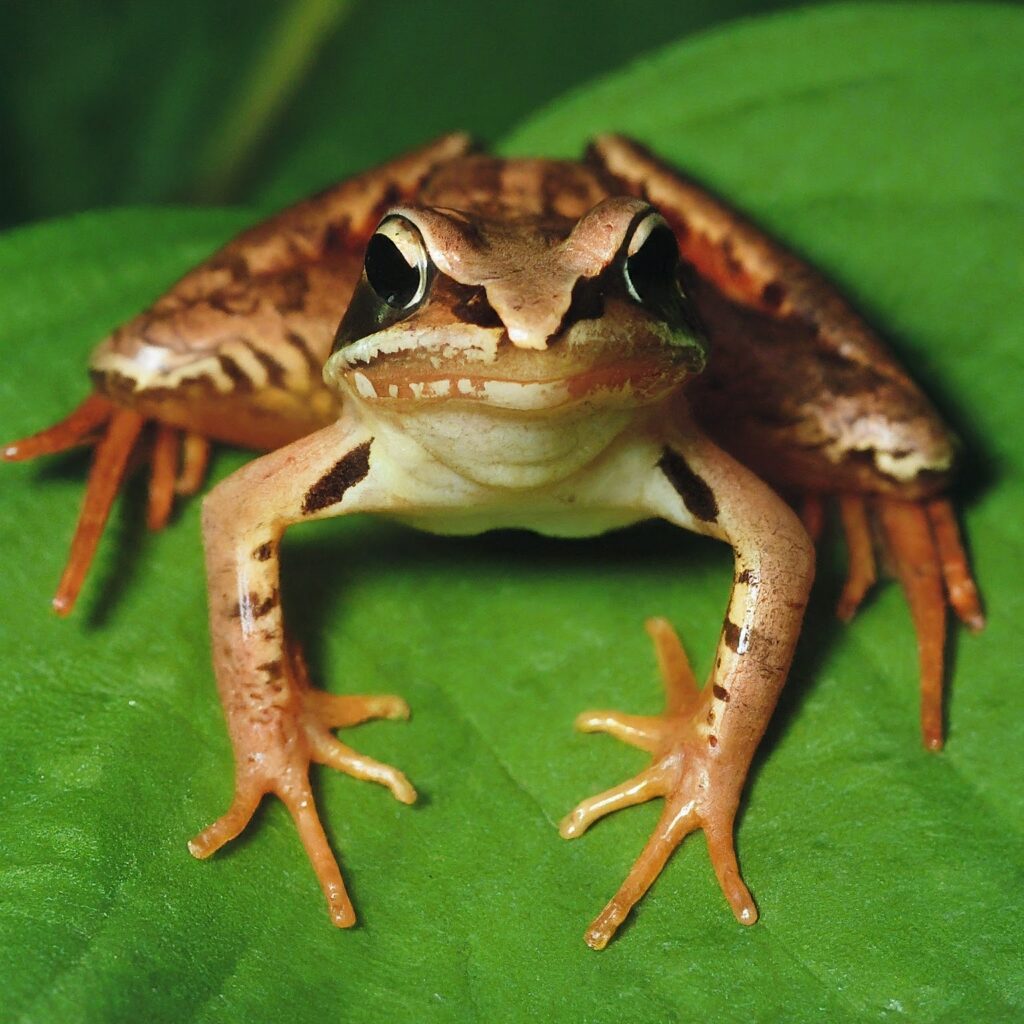
Time to Hear: Early-April to Mid-April, some snow on ground under trees, pond water cold, calls 1-2 weeks
Where to Hear: Temporary woodland ponds, bogs, open meadow pools.
The American Robin is not the only sure sign of spring. The Wood Frog is a terrestrial species for most of the year.
For herpetologists (those who study amphibians and reptiles), they are first sign that spring is around the corner.
When temperatures start rising in the spring, the wood frog emerges from hibernation from under leaf litter in forest.
In actual fact, the wood frog does not hibernate like some mammals, such as bears, do.
Its body temperature instead drops to that of its environment, and it can actually freeze almost solid!
Can wood frogs freeze?
The wood frog has [cyto=cell], known as cryoprotectants [cryo=cold]
These cells allow it to partly freeze without damaging cells when the temperature falls below zero Celsius.
Do wood frogs need to freeze?
It can not totally freeze, with an insulating layer of leaf litter and snow on top of perishing over the winter.
When temperatures are right, wood frogs thaw out and head to local breeding pond in masses.
Males arrive first and start calling in a group, called a chorus.
What sound does wood frog make?
Wood frogs calling in a chorus sound like a bunch of ducks quacking in the distance.
If you are walking through wet woods in the early spring and hear this sound, it is probably wood frogs.
You have to be lucky to catch them calling, since they will only call until the females arrive, which could take 1-2 days weeks, depending on weather conditions.
How do wood frogs reproduce?
Once the females arrive, breeding ensues and is done all in one night usually.
Females deposit egg masses communally, meaning in one general location.
Usually, one favorite dogwood shrub is chosen in standing water, where the water depth and temperature are just right.
It allow eggs and then tadpoles to develop quickly before the pond dries up.
Do female wood frogs die after laying eggs?
The simple answer is no they don’t die, Once egg laying is done, both males and females disperse back into the woods to forage till their next hibernation.
Tadpoles emerge as froglets a few weeks later. Just in time, since the water level in the pond is usually pretty low.
Now that you know a bit about where and when to find wood frogs, go out and listen for them.
Early evening is usually best, but if your timing is right you may be able to hear them calling during the day.
Western Chorus Frog (Pseudacris Triseriata)
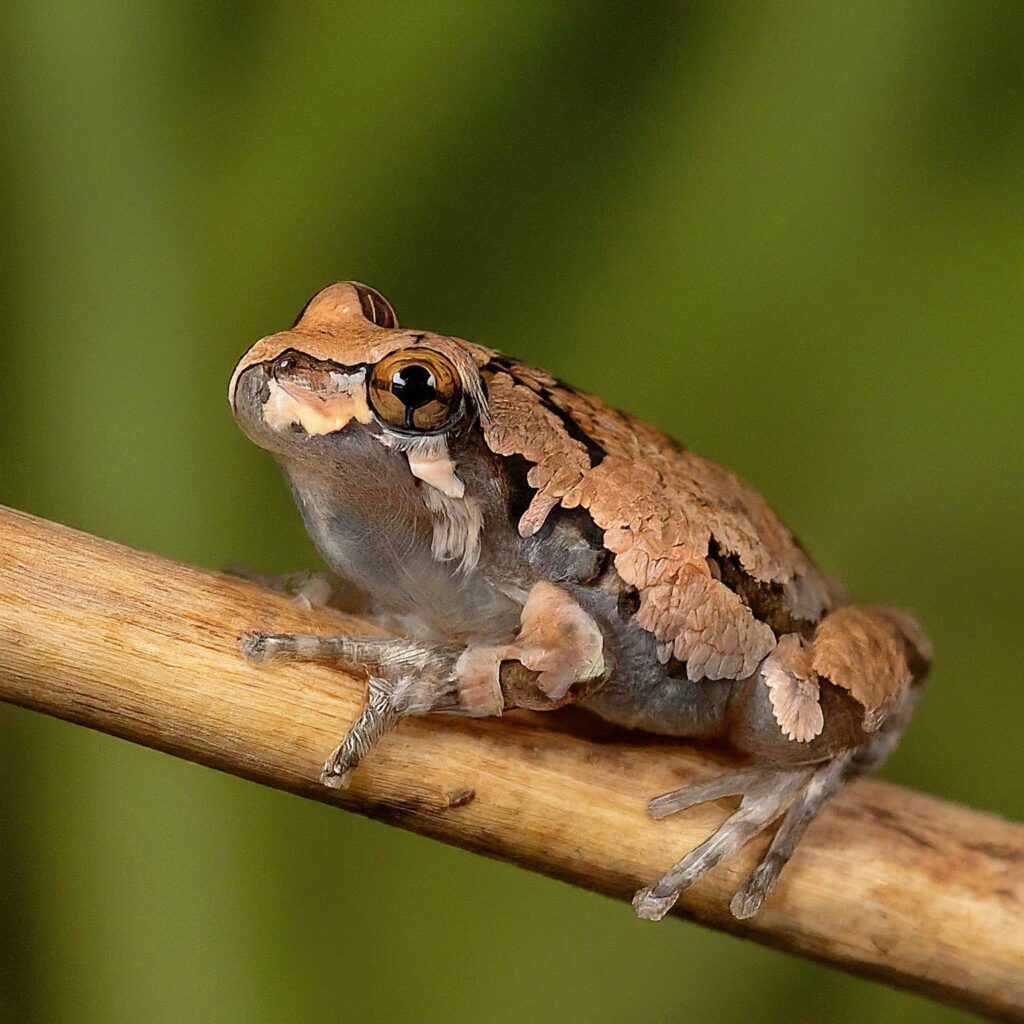
Time to Hear: Early April to mid-May, calls for 3-4 weeks, may start calling before wood frog.
Where to Hear: Temporary open meadow pools, sedge edges of ponds, shrubby wetlands.
The chorus frog is a tiny frog, about 1 1/2 inches long. A sure sign that spring is here is the call of the Chorus Frog.
What sound does western chorus frog make?
Chorus frogs call for a longer time than wood frogs are heard well into may until spring peppers arrive.
Its call sounds like a thumb running over a cheap plastic comb running from large to small tooth end.
It can be found calling in the early spring in wet meadows that are inundated with spring meltwater and rainwater.
Even though it is a small frog it sets up a territory and will defend it from other chorus frogs.
It crawls onto a narrow stem of grass or sedge and sings, warning other males, and hopefully, attracting nearby females.
Once Female selects a male, she will approach and allow the male to externally fertilize her eggs like fish.
What is the purpose of Amplexus?
The male clamps on female from behind (known as amplexus) and as the female deposits her eggs, male fertilizes them.
Is Amplexus internal or external? So, its quiet obvious that Amplexus is an external fertilization process.
Each egg is deposited singly spaced, evenly along the narrow stems of grasses, sedges, or rushes,
that are in water deep enough to allow eggs and tadpoles to develop before the meadow dries out in early summer.
Female frogs leave after laying their eggs. Males will return to their calling perch to attract females to mate ahain.
Northern leopard frog (Rana pipiens)
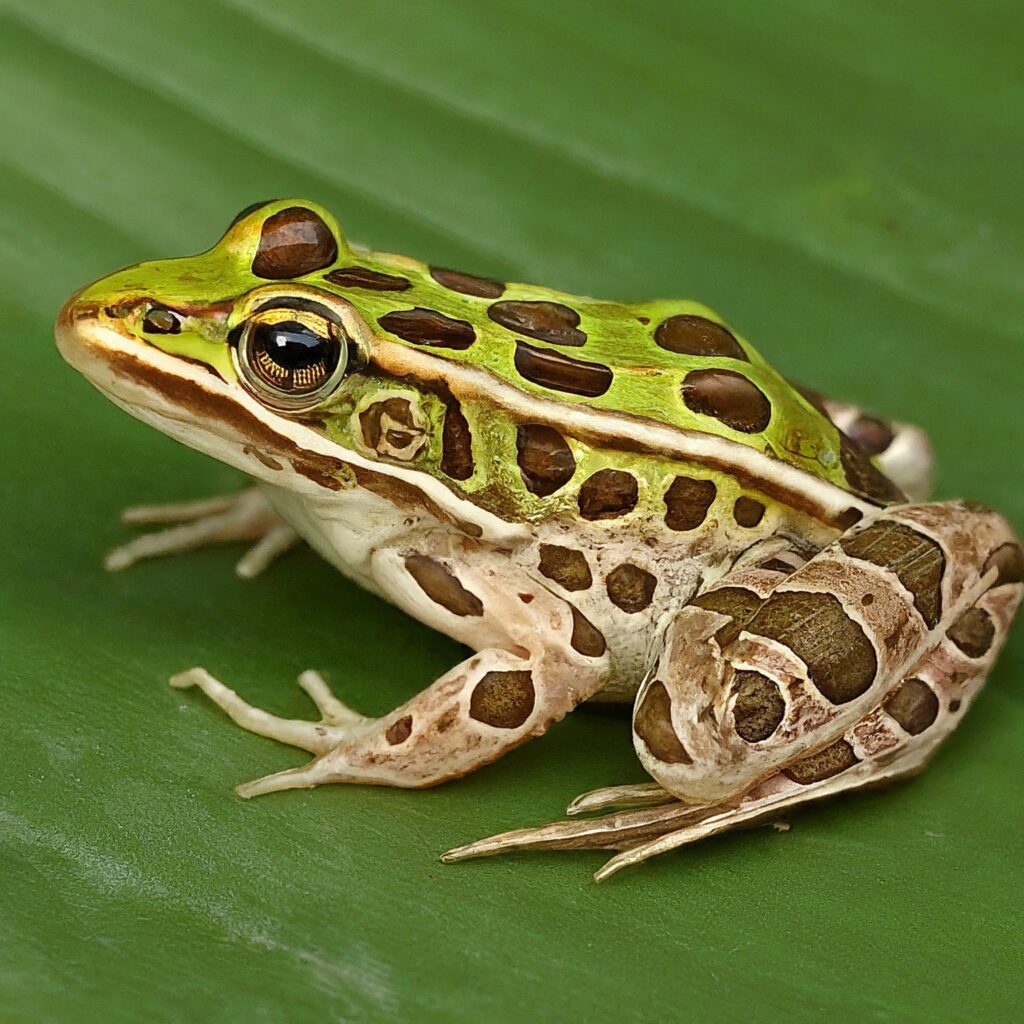
Time to Hear: late-April to July, calls over many weeks.
Where to Hear: Edges of ponds, marshes, lakes, rivers, and streams. Also found in farm sloughs as they hang out in fields and meadows foraging in the summer.
What sound does northern leopard frog make?
Northern Leopard Frogs are the first prolonged breeder to start calling in the spring.
Wood frogs and Chorus frogs are known as “explosive” breeders as they breed quickly before their watery habitat dries up.
The Northern leopard frog is often difficult to hear calling because it calls in small groups like other species do but calls from the edge of a pond or marsh individually.
Their call sounds like a guttural snore but may vary to sound like it is hiccupping as it’s snoring.
As well, it can make a squeaky sound like a person rubbing their hands over a wet balloon.
The snore can often be confused with its close relative, the Pickerel Frog,
which also snores, but often has a softer snore (they often call underwater) which rises and falls in volume.
The Pickerel frog also starts calling a bit later in the season near bodies of running water.
The Leopard Frog is most resilient, next to the American toad, as its habitats are outside the breeding season.
How does a leopard frog reproduce?
It forages in meadows and fields in the summer, hence easier to find in summers than during the breeding season.
A field near a permanent water body will usually turn up many young froglets in mid to late summer.
If you are a cottager, you may have noticed the paucity of leopard frogs that used to once be abundant.
These declines are due to a variety of factors, including harvesting to be used as bait,
pesticides used (including lawn herbicides ), and loss of habitat due to construction (loss of both wetland and field habitat).
So, if you see a leopard frog, do not think of it as just ‘a common frog’, think of it as frog world representative.
Spring Peeper (Pseudacris crucifer)
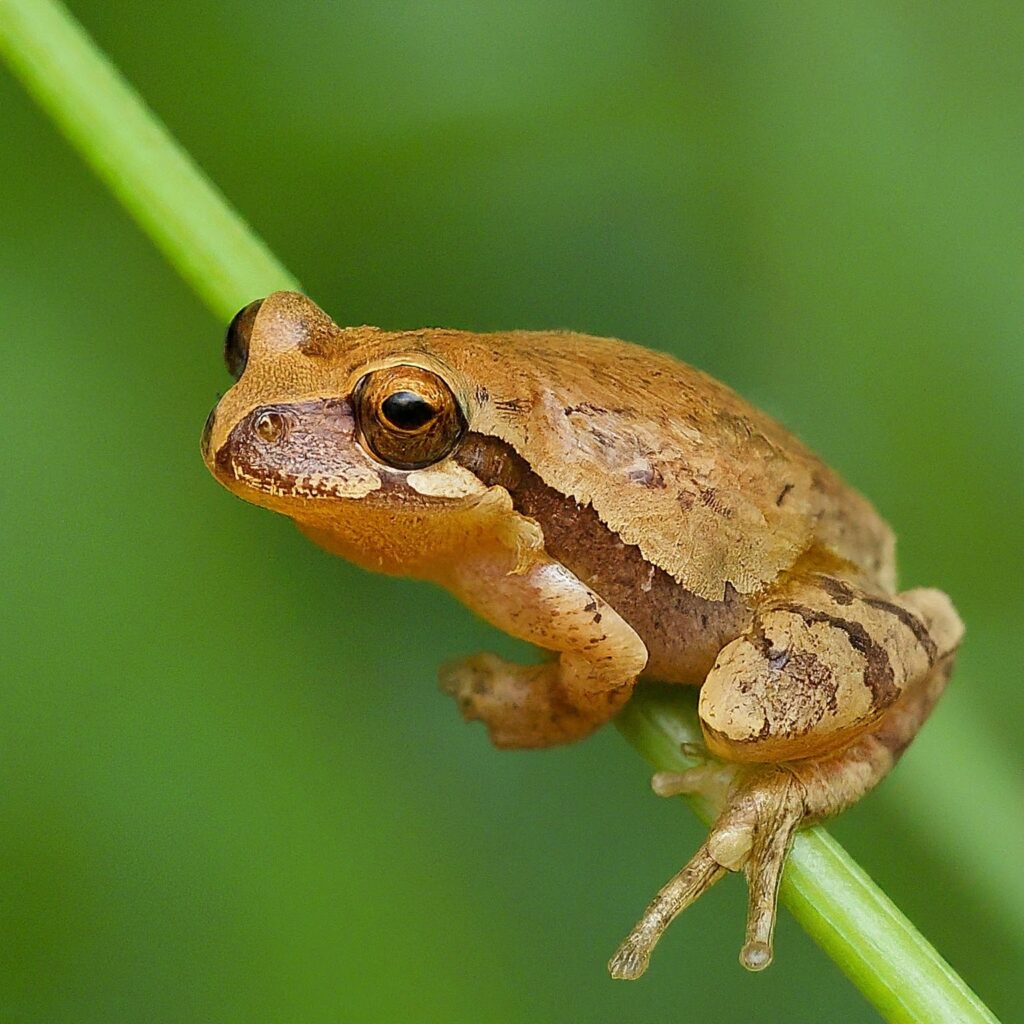
Time to Hear: mid-April to late-May, call for 3-4 weeks.
Where to Hear: Shrub swamps, shrubby pond and lake edges, meadows.
“Such a tiny frog for such a loud call,” most people say when they see the 1″ Spring Peeper. Its call is exactly the way it says, it peeps.
Why are frogs called peepers?
Each peep of a peeper has a short pause of about 1sec, depending on how cold the little guy is.
By himself, the lone peeper is not much to shake a stick at as far as volume goes.
Put him with his buddies and your ears will be literally ringing with the cacophony of noise they make.
What sound does Spring Peeper frog make?
A “blurr of noise” is definitely the correct phrase describing a full chorus of these frogs.
They are so called peepers because of their chirping call marking the initiation of spring.
The territorial call sounds somewhat like a chorus frog trill but is not as ‘comb-like’, rather, it is on one pitch and more musical.
At what temperature do peepers come out?
Peepers start calling early in the spring once the water temperature reaches about 8 C (46 F).
The water temperature may drop after that but calling will continue.
Where do spring peepers mate?
They sit just above the water, or partly in it, depending on which is warmer, the air or the water,
and call from this site until a female is attracted to this little Romeo and chooses to mate with him.
The male will defend his site from other males when he is calling.
If the male is off mating, he will often come back to find his call perch has been usurped by a ‘satellite male’.
They hover around an occupied call perch (often keeping low in the water, acting like females) until the occupant leaves to mate, then they steal his site to start up their own love call.
Where do peepers go in the winter?
When you’re out near shrubby lake or pond shores, keep an ear open for these guys. They’re the easiest frog to hear, but probably the hardest to see.
Let me know if you are successful at seeing one. I’ve spent a long time staring at the base of dogwood shrubs before I actually saw one.
American Toad (Bufo Americanus)
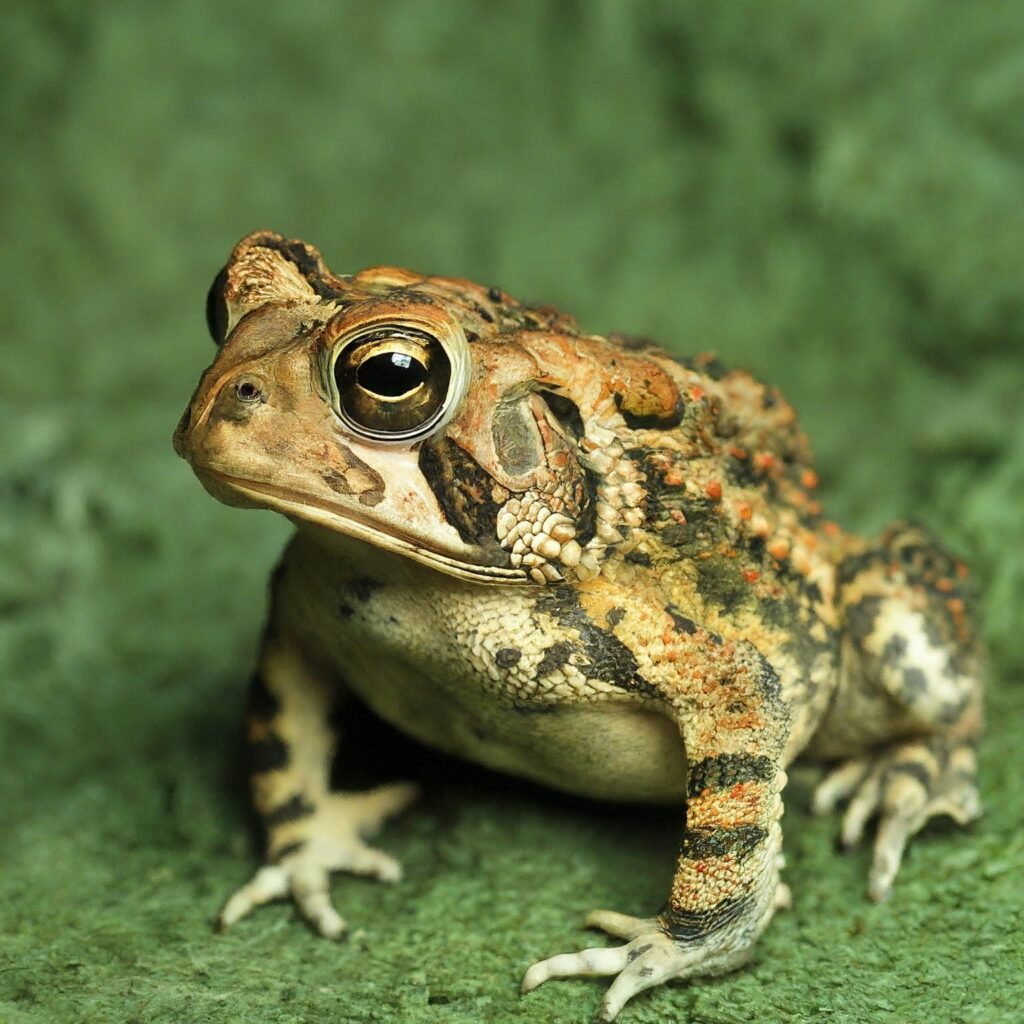
Time to Hear: early-May to mid-May, ‘explosive’ breeder with short 1 week breeding period
Where to Hear: Temporary pools or ditches, ponds, marshes, lakes, flooded meadows, slow rivers.
What sound does American Toad make?
One of my favorite calls, the American Toad has a long-drawn-out trill that can last for several seconds.
We can distinguish each individual toad can be by the pitch of its call.
American toad is an explosive breeder, it only calls for a short time in May, depending on weather .
What temp do spring peepers come out?
It starts calling when the air and its internal body temperature reaches 13 Celsius
(you don’t really want to know how they managed to find this out…think ‘proctologist’).
How do Spring peepers breed?
When the conditions are right, the females moves in pond and breeding may take place all in one night.
Toads are resilient creatures we find where there is a suitable breeding pond within walking/hopping distance.
Where do spring peepers mate?
They don’t really jump or leap like other frogs of foraging areas.
So, you can find them in your backyard outside the breeding season, foraging for grubs, worms, and slugs.
Therefore, some people put out toad houses in their garden, as they eat the bugs that can ruin vegetable crops.
I do not recommend transplanting a toad into your garden though as the poor thing will most likely die.
They usually try to move back in their natal breeding pond dies over winter, if they fail in burrowing below the frost line.
Provide sheltered areas and a pool of water and if you are lucky, you’ll find a toad in your backyard.
If your pool is deep enough (over 2 feet or so) then you may even have local toads calling and breeding, there.
Gray Treefrog (Hyla versicolor)
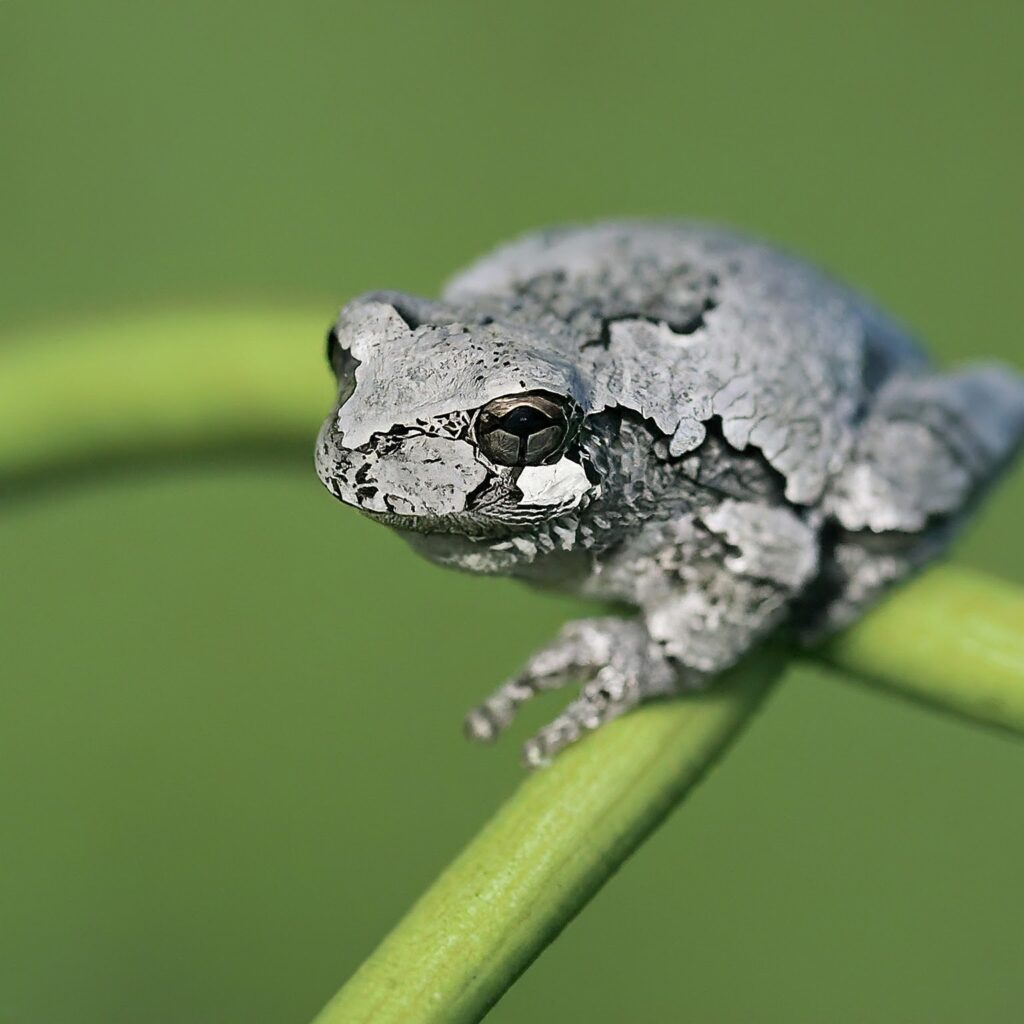
Time to Hear: mid-June to mid-July, calls for 3-4 weeks.
Where to Hear: Temporary and Permanent pools, ponds, oxbows, and floodwaters along rivers, often waterbody and shrubs.
The Gray Treefrog (Hyla Versicolor) starts calling in early to mid-June when nighttime temperatures reach 10C (50F) or so.
You may hear them from trees outside of the breeding season, even on warm days in the winter or early spring.
What sound does Gray frog make?
It sounds almost like a bird, especially a red-bellied woodpecker, as its call is a loose, slow, resonating, bird-like trill that lasts about one second.
If you are out birding and hear a call that sounds like a woodpecker’s call, it’s a gray treefrog calling from a tree.
Where do gray tree frogs mate?
In the breeding season, they come down from the trees and call from the edge of ponds near their treetop lookouts,
usually using a convenient calling perch in the water such as a twig or stem.
You won’t mistake them for birds if you hear a large chorus calling as they call quite vigorously and repeat the call every few seconds or so.
Even trying to find them when you hear them calling is a chore and requires a keen eye.
Can tree frogs camouflage?
They can change their skin coloring to match the background of their perch (from Gray to green only-not purple or pink etc.) so they blend in with bark very well.
Trying to find them outside the breeding season is almost impossible.
Look in the forks and hollows of trees to see if they are roosting there.
They are up to 2 1/2 inches long so are not as hard to spot as a chorus frog or spring peeper.
Green frog (Rana clamitans)
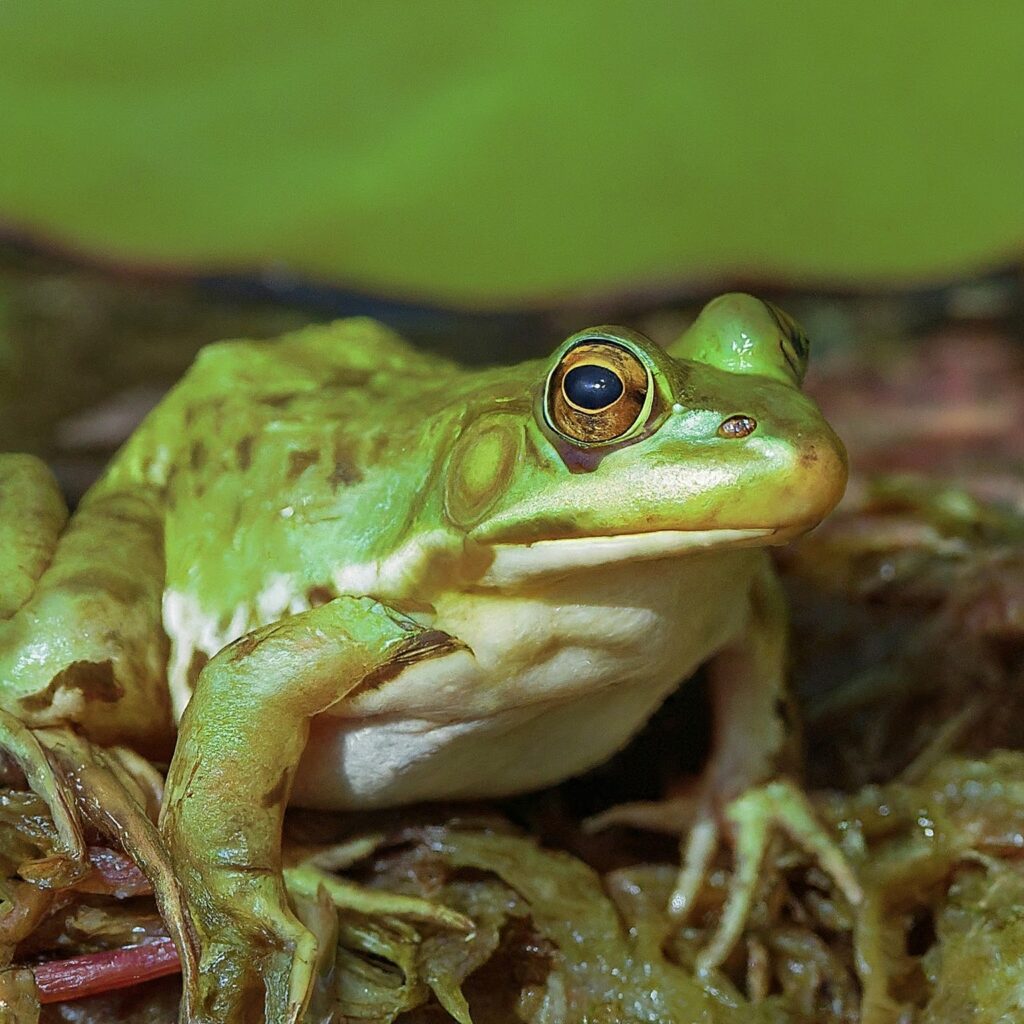
Time to Hear: late-May to August, prolonged breeder 1-3 months.
Where to Hear: Edges of ponds, streams, springs, marshes, bogs, slow sections of rivers, oxbow lakes.
On land sometimes, but always near water. Ah, the green frog. A common frog in ponds and marshes, but easily overlooked.
They camouflage well with their green and brown bodies which blend into the shoreline where they hang out.
They are more aquatic widespread species than the leopard frog but less so than the bullfrog.
What sound does Green frog make?
To hear a good green frog chorus you need to go at night, but they often hear them calling during the day.
The sound they produce is similar to loose banjo strings, A short ‘gunk’ sound. when we pluck its strings
They also give a throaty rumbling territorial call which may sound similar to a bullfrog.
If you hear the banjo pluck in the same area as the rumble, then they are green frogs fighting over territory.
If you get enough of these guys fighting, they may sound like a wood frog chorus, with all the overlapping calls.
These guys start singing about early to mid-June and continue through July, sometimes into August.
How do Green frog Mate? Where they do it?
The females choose the male with a territory containing abundant submerged and floating vegetation.
They lay their eggs in a floating mass on top of the aquatic vegetation.
When the eggs hatch, the fat, fish-like tadpoles remain in their pond over winter.
You may find some early the next spring moving about in the water long before anything else is stirring.
It may take 1 to 2 years for green frogs to metamorphose from tadpoles to adults.
Therefore, they need a deep pond which does not freeze to the bottom as they bury in the mud or rest on the bottom in the winter.
Bullfrog (Rana catesbeiana)
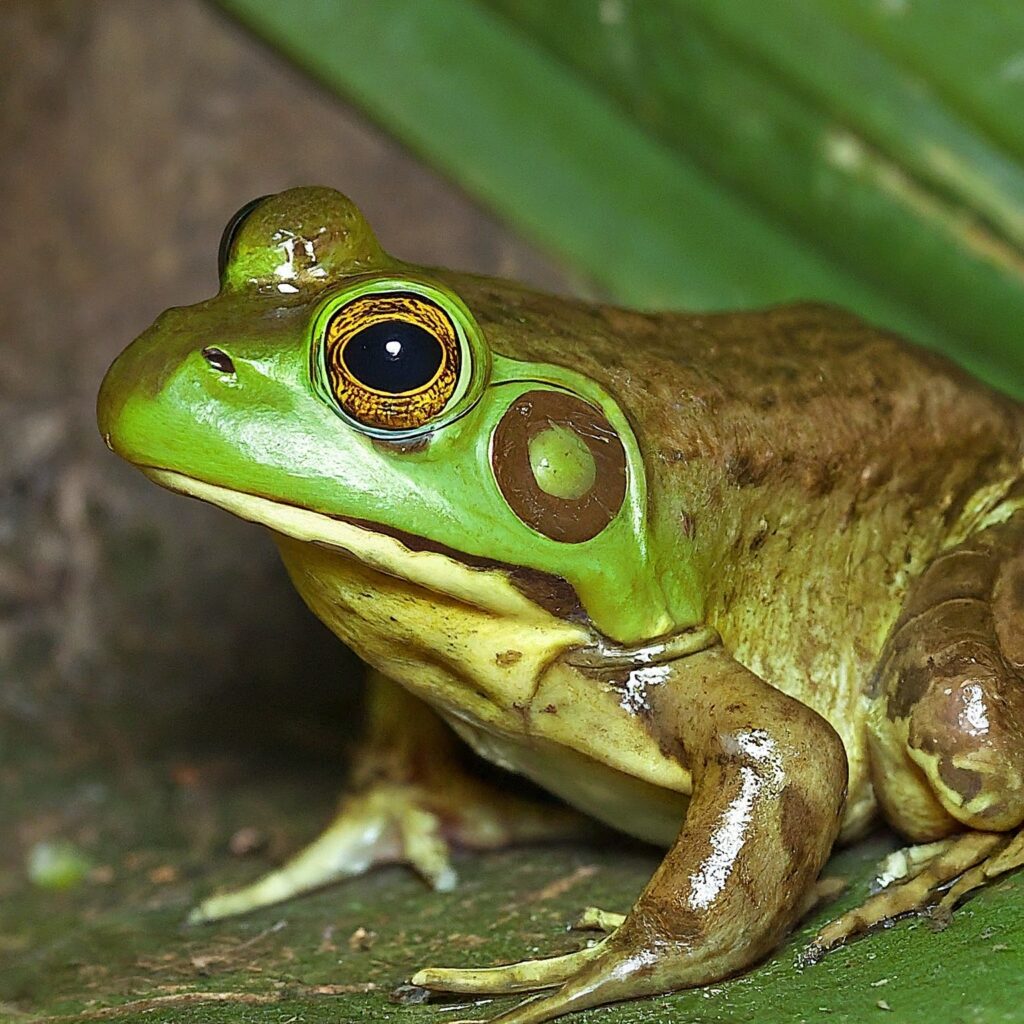
Time to Hear: mid-June to early August, call 3-4 weeks
Where to Hear: Permanent ponds, lakes, marshes, reservoirs. Larger, deeper water-bodies than for other species.
The Bullfrog is the largest of the frogs in Ontario, and the most aquatic.
What sound does Green frog make?
It sounds somewhat like a bellowing bull, hence its name. It has a low rumbling ‘rrruumm’ or ‘jug-o-rum’ call.
Unlike other frog species, the bullfrog males will overlap each other’s calls.
When one starts up, the rest in the chorus join in until it’s a cacophony of noise.
This lasts for a while then dies down, only for one to start up again and everyone once again joins in after a few seconds.
This makes it difficult to distinguish how many males are calling in a chorus.
As well, there could be a few of these distinct choruses in a lake which makes it even more difficult to count them when everyone is overlapping calls.
It is best to try to count a chorus by keeping track of each frog as they join in, and, to listen for differences in the pitch of voices as older males have deeper voices.
How do Bullfrogs Breed? Where do they mate?
The bullfrog could be considered the ‘bully’ (no pun intended. well maybe) of the frog world in that it will take over the prime breeding areas of a lake or marsh, and if any other frog gets in its way…he has his ‘friend’ for lunch, literally.
Fact: They are cannibalistic in nature, including the tadpoles.
Not that the bullfrog is mean, he is just bigger and bolder than his counterparts.
Males will physically wrestle each other for territories, with the ‘best frog’ winning.
Larger males thus establish the best territories and mate with the most females.
Males don’t seem to live as long as the females though, probably due to their conspicuous calling and activity (birds spot them easily).
Some adults can reach enormous sizes though. One last tip, frogs like water, so the time to find them calling is when it is raining.
A humid or drizzly night is also a good night for finding frogs, especially if it is warm and calm. Remember, think like a frog if you want to find them!
